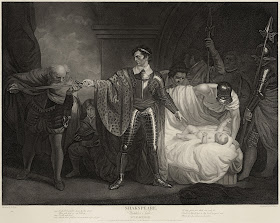 |
| Leontes being an idiot. Public Domain. |
In my L post, we learned of that dreadful man, King Leontes, who destroyed his own family and his relationship with his best friend because…(checks notes) his wife persuaded his friend to stay a bit longer when he couldn’t, and touched hands in a friendly manner…
Let’s continue and talk about the whole play.
So, that idiot Leontes puts his Queen, Hermione, on trial. Word comes into the courtroom that their little boy Mamilius has died of stress at his mother’s treatment. Hermione faints and is carried off. Her loyal lady Paulina returns a while later with a baby girl, pleading with Leontes to check her out and see how much the child looks like him. He orders the baby to be abandoned and orders Paulina’s husband, Antigonus, to do the dirty deed.
Then Leontes hears his wife has died. He never does ask to look at the body or have a funeral. Interesting, that.
Polixenes, the friend, flees with the help of a courtier called Camillo, who goes with him.
Antigonus arrives in Bohemia, that landlocked country which, in Shakespeare’s imagination, has a sea coast, and makes a speech saying he thought he might as well leave her in her real father’s kingdom. This is the famous “Exit, pursued by a bear” scene.
The child is found and brought up by a shepherd and his son(who saw Antigonus being eaten by the bear).
Sixteen years later, Perdita is a beautiful young woman, in love with a young man called Florizel, who is really the son of King Polixenes. There is a sheep shearing festival and a lot of singing and dancing. (When we performed this play at university I played the role of Mopsa, the young shepherd’s girlfriend, and got to sing a song with Dorcas, the other shepherdess, and Autolycus, a pedlar/pickpocket). Perdita, of course, is too dignified to do any of this stuff; she is a princess, though she doesn’t know it, and behaves like one. This is a case of nature versus nurture, and nature will always win.
Among the audience are King Polixenes and Camillo, in disguise. Polixenes has heard that his son has been dating a peasant girl and wants to know what’s going on. He is impressed with Perdita’s beauty and dignity, especially when he hears her speak her famous flower speech, but come on, this is a peasant! No way is she marrying his son!
Polixenes reveals himself and orders the young couple to break up. However, Camillo, who has become homesick, takes them aside and advises them to go to Sicilia, the home of Leontes. He will go with them. They are followed by the terrified shepherd and his son, who are afraid of what the king might do to them for letting his son romance Perdita, and bring along the stuff found with her as a baby, to prove she was adopted.
Leontes is a much-changed man and is pleased to see Florizel and Perdita, whom he assumes(correctly, as it happens) is a princess.
Polixenes turns up, as do the shepherds, and, after a lot of discussion, it’s realised that Perdita is Leontes’ daughter. This all happens offstage and we hear about it from the shepherds who, to their delight, are made “gentlemen” as a reward for having looked after Perdita.
Remember what I said about Leontes not having seen his wife’s body or given her a funeral?
Paulina invites everybody to her house, to see a statue of Hermione which is just completed. Of course, we can figure out what’s next. It’s the real Hermione, who has been hidden all these years, and pretends to be a statue; Leontes does remark that the statue looks much older than his Queen.
Or maybe it was magic, but I don’t think so. Anyway, Leontes doesn’t care, he has his wife back and has turned into a much nicer man.
A pity about his son. That character actually is dead, alas!
Oh, and the widowed Paulina gets to marry Camillo.
I first saw this play on a school excursion to the touring Royal Shakespeare Company when I was in Year 12. The roles of Hermione and Perdita were both played by the same actress, as is fairly common these days, though they do have to have someone else doing it, silently, in the last scene when both characters are in the same room. The actress was a much younger Dame Judi Dench. If you have only seen her as an older woman, you probably can’t imagine her young, but she would have been in her thirties then. She was wonderful!
There have been a fair number of productions over the years. The first film I saw, late at night, on a black and white TV, was made in 1967, with Laurence Harvey as Leontes, Moira Redmond as Hermione and Jim Dale, who has become an amazing audiobook reader(He did the American Harry Potter books) as the mischievous Autolycus. I remember that the first half of the story, in Sicilia, was done in Mycenaean style costumes, then in Bohemia everyone was dressed Elizabethan. It may be my faulty memory, but it’s a strong one.
See you tomorrow when X will be for EXtras, about stuff I hadn’t room for in other posts!
So Leontes gets a happy ending and Antigonus gets eaten by a bear. Hardly seems fair.
ReplyDeleteIt amuses me to imagine that Hermione has been standing as a statue for the entire time, 16 years or whatever.
ReplyDeleteLeontes comes off as not too bright...
ReplyDeleteRonel visiting for the A-Z Challenge My Languishing TBR: W
Hi Anne! Um, no, sorry! She has been hanging out at Paulina’s place for all those years, I got the impression that the statue was Paulina’s recent idea. During that scene, she warns Leontes not to touch it because the paint isn’t dry! I wonder why? 😂
ReplyDeleteAgreed, Ronel, not very bright!